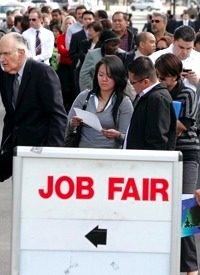
News that another 263,000 jobs were lost in September has led a number of uninformed analysts to wonder whether the recession will continue.
Analysts had expected job losses to be only 175,000, and the September figures represented an increase over the August number of 201,000 jobs lost in the economy.
But the employment picture is even worse than that. The government’s unemployment statistics are now likely undercounting the unemployed. “About 824,000 more jobs may be subtracted from the payroll count for the 12 months through last March when the figures are officially revised early next year,” Bloomberg.com reported October 2.
Bloomberg stressed that the whole model for counting the unemployed may be “broken.” 807,000 people dropped out of the workforce entirely in September, and are therefore not being counted in official unemployment numbers. The unemployment rate attempts to measure anyone who has looked for a job within the past year and is at that time not employed. Three million people have dropped out of the workforce entirely since the beginning of the recession. While many of that number may be early retirees or working mothers who have decided to make a go on a single family income, a good number of these people have simply become discouraged from finding work.
September also saw the first major reduction in government employment, as some of the “stimulus” funds had postponed most government layoffs at the state and local levels. The federal government has been able to keep borrowing and inflating the dollar in order to keep employing a large number of people. But state and local governments are often required to balance their budgets annually. As state and local governments feel the sting of the recession, major government layoffs are inevitable. And that will increase the number of unemployed further.
All this negative information about the current job market leads to the question: Is an increase in the number of unemployed an indication the recession will continue? In a word, no.
But that hardly means the United States is on a path to economic recovery. High unemployment numbers are simply a delayed symptom of the current economic contraction. Economists define a recession as two quarters or more of negative Gross Domestic Product growth, and the current recession officially began at the end of 2008.
Unemployment typically begins to rise at the beginning of an economic contraction, and that rise may last for a year or more after a recession. For example, the 2001 economic contraction involved two non-sequential quarters of negative growth (so technically it wasn’t a recession because the two negative growth quarters in 2001 weren’t sequential) during the 2001 calendar year. But even though the economy as a whole experienced positive GDP growth throughout 2002 and 2003, unemployment continued to rise until the middle of 2003.
The GDP has yet to register a positive gain since the second quarter of 2008. The first numbers on U.S. GDP for the third quarter of 2009 won’t be out until October 29. So the recession hasn’t officially ended. Since job losses will likely continue for a year or more after the Gross National Product begins to register positive numbers, its reasonable to expect unemployment to continue to rise at least through the end of 2010.
GDP, which measures the economic value of everything that the nation produces, is the key measure for a recovery. It’s the only real sign that the has increased the value of its economic goods and is ready to begin rebuilding the economy.
Even after the recession officially ends — we’ll find out October 29 if it has officially ended — the nation will have a long, tough time in the employment markets. But there’s a wildcard in this recession. Because the Obama administration has been using massive government borrowing to "stimulate" the economy, it’s possible that the economy will notice a slight economic gain this year as part of this stimulus/debt bubble and then see another crash as the stimulus/debt bubble pops. The stimulus/debt bubble could pop just like the housing bubble, leading to a deeper recession and still greater unemployment numbers.
Photo: AP Images



